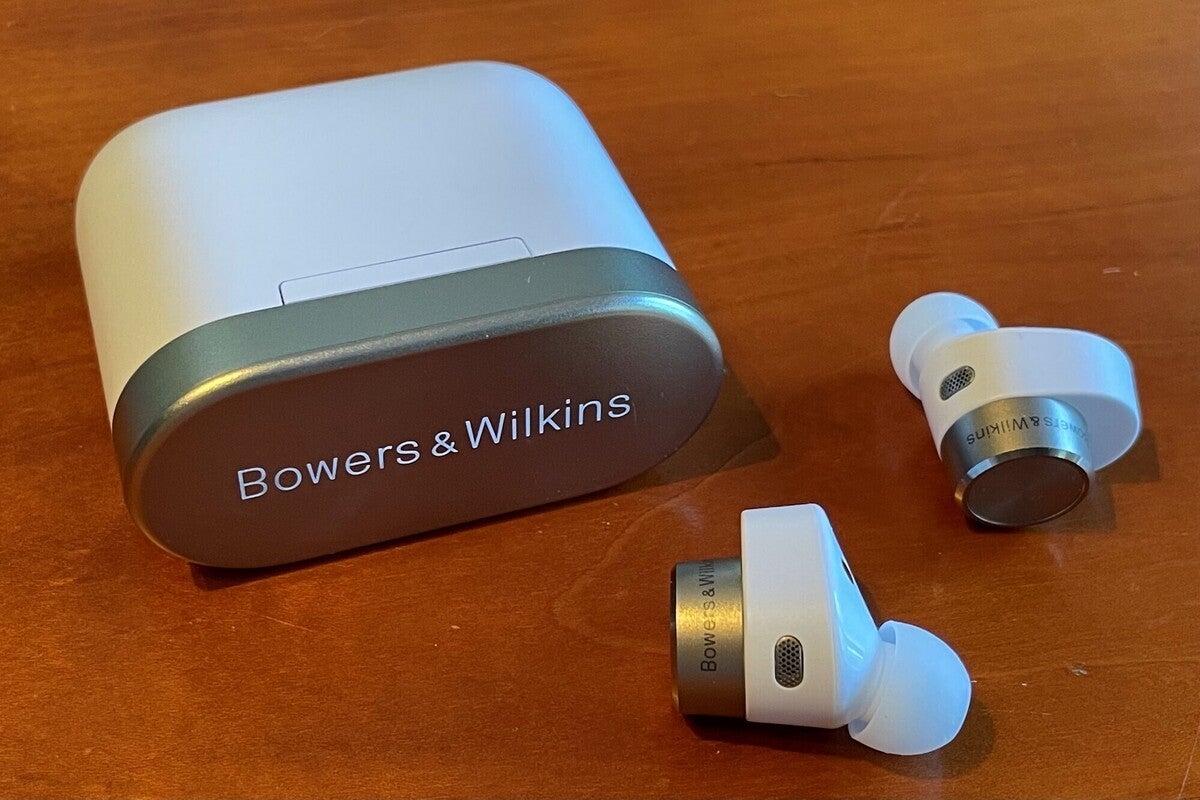Bowers & Wilkins PI7 true wireless in-ear headphone review
Few audio companies in the world can hold a candle to the storied heritage of venerable British speaker maker, Bowers & Wilkins. B&W’s speakers are used in the some of the world’s most renowned recording studios, including the famed Abbey Road, and they’ve been exhibited at New York’s Museum of Modern Art.
While B&W has dipped its toes into the wired, wireless, and ANC headphone market before, the manufacturer has been noticeably absent from the true wireless headphone arena—until now. B&W’s PI7 are its first true wireless in-ear headphones, and they raise the performance bar, introduce super-cool innovations, and sport great industrial design; alas, they also suffer from some of first-generation quirks you’ll want to be aware of. The company launched the less-expensive ($250) PI5 at the same time, which we have not evaluated.
This review is part of TechHive’s coverage of the best noise-cancelling headphones, where you’ll find reviews of the competition’s offerings, plus a buyer’s guide to the features you should consider when shopping for this type of product.
Design and build quality
The PI7 come in your choice of matte white or charcoal finishes with matte gold accents. The matte finish on the case ensures it won’t slip out of your hands, as the glossy-smooth AirPod and AirPod Pro cases are prone to do. Comparing the two, the B&W PI7’s case is significantly larger—roughly 40 percent larger—than the AirPod cases in every dimension.
The PI7’s build is just beautiful, and its specifications are formidable. The rated frequency response is 10Hz to 20kHz (no tolerance given). There are two drivers inside each earbud: A 9.2mm drive unit and a high-frequency, balanced-armature driver. If you’re unfamiliar with that technology, a balanced-armature architecture relies on an electrical signal to vibrate a small reed or paddle thousands of times per second. The reed is balanced between two magnets, hence the name. Armature drivers are small and light and similar to a multi-driver loudspeaker design, can be tuned to handle a different range of frequencies.
[ Further reading: The best high-res digital audio players ]
B&W says that a dedicated amplifier on each of the four total drive units in the earbuds ensures “exceptional control, superlative dynamics and deep, accurate bass.” Marketing lingo aside, the design works, and they sound really good as I’ll relate in more detail shortly.
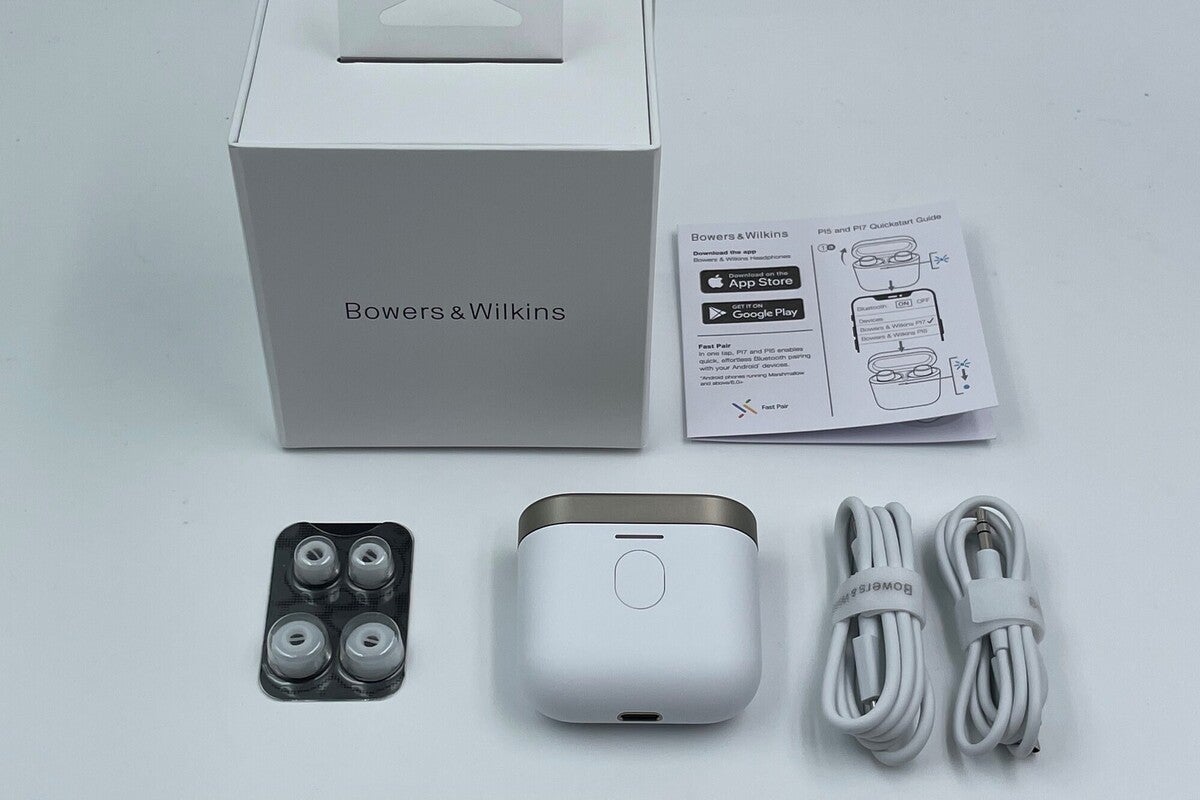 Theo Nicolakis / IDG
Theo Nicolakis / IDGThe B&W PI7 comes with three pairs of silicone ear tips, a USB-C to USB-C charging cable, USB-C to 3.5mm cable, and a ProCase charging case that doubles as a Bluetooth streaming transmitter.
Tapping the flat side of each earbud performs defined functions: Pressing and holding your finger on the left-hand earbud for one second will toggle noise cancelling and give you a distinctive tone to confirm. Pressing and holding the right-hand bud for one second will activate your smart device’s voice assistant. With music playing, a single tap toggles play/pause, a double tap advances to the next track, and a triple tap goes to the previous track. During a phone call, the function switches to an answer/hangup toggle. Volume control is handled by the source device. These features all worked as advertised in my testing.
AAC and aptX Adaptive codec support
The PI7 supports Bluetooth 5.0, and connections were generally strong. I could easily move 33 feet and further from my source, including getting the signal through walls, doors, and floors. I did experience some random Bluetooth anomalies—including drop-outs during phone calls—that I couldn’t quite pin down as a pattern or confirm if they were related to potential interference. I could only fix things by re-seating the headphones back in their case.
The PI7’s selling point is its codec support. The PI7 feature SBC, AAC, and Qualcomm’s aptX Adaptive codec. Apple’s AAC codec delivers audio in 16-bit resolution and a 44kHz sampling rate. I had no problem connecting the PI7 to my iPhone 12 Pro or 2019 15-inch MacBook Pro via Bluetooth.
Qualcomm’s aptX Adaptive codec supports wireless high-res music playback to your PI7 at up to 24-bit resolution and 48kHz sampling rates from sources that support the codec. AptX Adaptive is backward compatible with aptX Classic and aptX HD. While high-res playback looks fabulous on paper, it was more problematic in practice.
I could not connect the PI7 successfully to any of the Astell&Kern high-res digital audio players I had on hand, including the A&K KANN, SR15, and AK70 MKII. I couldn’t connect the PI7 to my FIIO M9 high-res DAP, either. The PI7 paired, just fine but would go into a connect and disconnect loop on every device.
I was able to get the PI7 to work on my FIIO FX7221 and Pioneer XDP-100R high-res DAPs, but the compatibility issues I encountered meant I couldn’t test the PI7 using an aptX HD connection for high-res music playback.
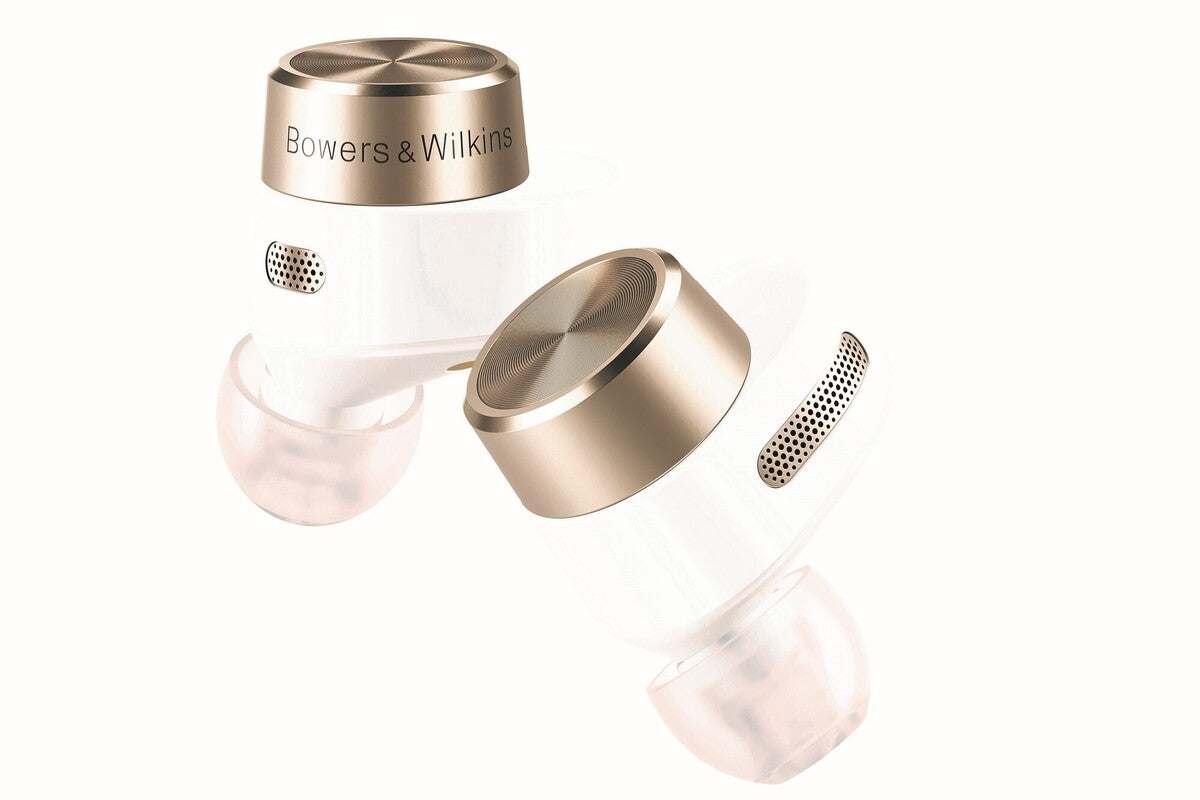 Bowers & Wilkins
Bowers & WilkinsThe B&W PI7 are also available in a matte white finish.
A B&W representative said the company is aware of these issues and believes the problem is related to the aptX Adaptive codec. B&W is working with Qualcomm to learn more. In the meantime, if you’re planning to pair the PI7 with a high-res music player, you might be out of luck in the short term. Hopefully, B&W and Qualcomm will identify the root cause soon and B&W will release a firmware update to fix the problem. Frustrating as it was, I did not dock the PI7 any points for this problem since B&W is aware of it and is working on a solution.
A beautiful listening experience
As I mentioned above, the PI7 has a known problem connecting to several high-end, high-res DAPs. I therefore tested the B&W PI7 on an iPhone 12 Pro, a 2019 15-inch MacBook Pro, a Fiio X7221 DAP and a Pioneer XDP-100R DAP. The Fiio and Pioneer use aptX Classic. I used my Roon Nucleus server to stream music to the iPhone 12 Pro, MacBook Pro, and Pioneer XDP-100R with content from my local media library and Tidal. For the Fiio, I used a variety of high-res and CD-quality source files stored locally on the device.
The B&W PI7’s musical presentation for a pair of true wireless headphones is nothing short of fabulous. Music is rich, lush, dynamic, detailed, and engaging. B&W’s PI7 headphones create a defined, layered soundstage with instruments and vocals placed firmly in space and time.
The PI7 beautifully rendered the iconic voices of Adele, Natalie Merchant, Alicia Keys, and Bono. Among the most intoxicating during my review period was Andrea Bocelli’s vocals on “Tremo e t’amo” from his album Sogno. The hairs on arms stood on end as I became lost in the tenor’s vocals.
Bass lines on Katie Melua’s “Love is a Silent Thief” were deep and tight, with Ms. Melua’s vocals cleanly presented and layered in front of the instrumental soundstage. Bass lines on Sade’s “Soldier of Love” and Lorde’s “Royals” dropped in tight, detailed, authoritative bursts. Bass was always controlled. The subsonic bass opening of Bonnie McKee’s “Trouble” was skull-vibratingly intoxicating. As I’ve noted in other reviews, when using the aptX codec I noticed consistently elevated upper bass. While some may like that extra boost, it tends to add some bass bloat.
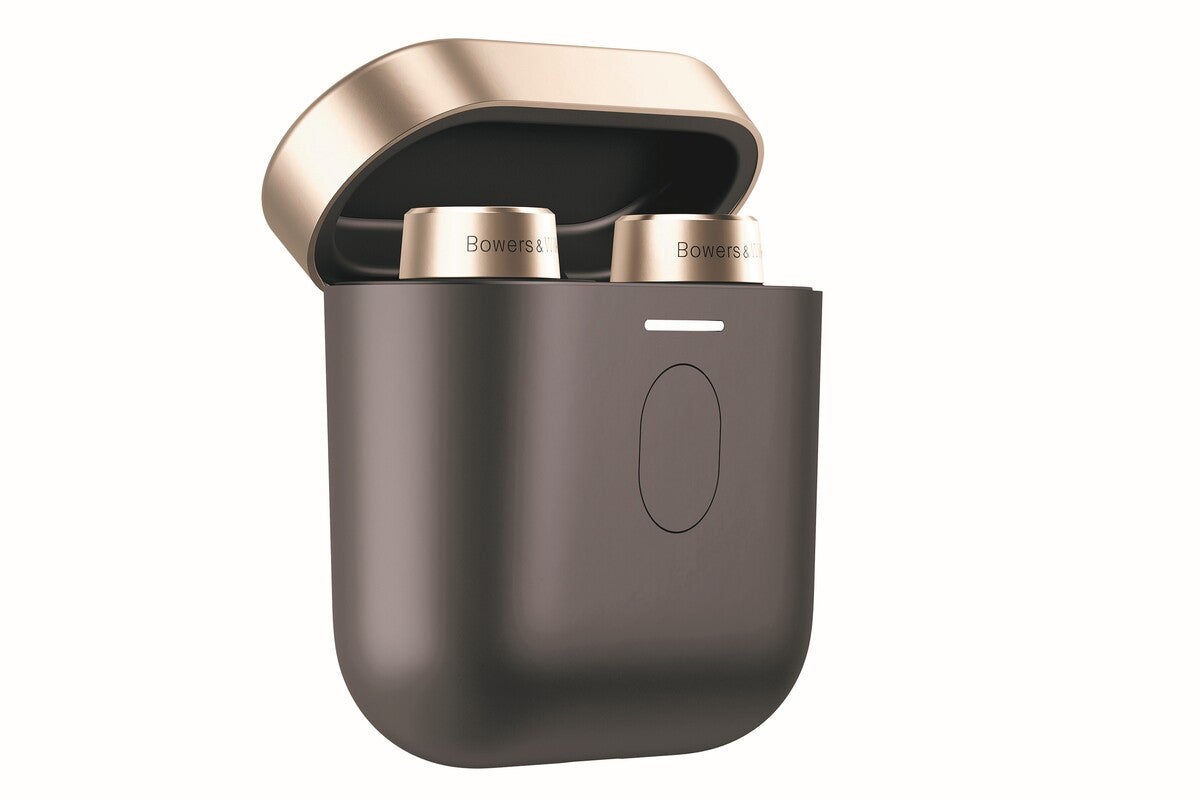 Bowers & Wilkins
Bowers & WilkinsThe matte finish on B&W’s case helps ensure it won’t slip out of your hand.
Piano notes are so difficult for any speaker—much less headphone—to nail, but that’s exactly what the PI7 did. The opening keys of Lana Del Rey’s “Mariner’s Apartment Complex,” Adele’s “Hello,” and Billy Joel’s “Piano Man” were full bodied, tonally accurate, and detailed.
I absolutely loved the B&W PI7’s musical presentation. It’s a solid winner.
A true wireless headphone with a secure fit
It’s often a challenge for me to get in-ear headphone designs to fit well without falling out. B&W’s C5 in-ear headphones with their innovative loop design are the best fitting in-ear headphones I’ve ever used. The loop always kept the headphones in my ears without them sliding out.
While Apple’s AirPod Pro are among the better overall true wireless headphones I’ve tried, they still slide out more than I’d like. That’s not the case with the PI7—they are the best-fitting true wireless headphones I’ve used. The secret lies in the PI7’s elliptical shape that is designed to twist and lock into your ear’s concha. The twist and lock design works and works incredibly well—even during active workouts.
The earbuds (not the case) are IP54 rated for protection against dust and splashing water. This makes them perfect for sweaty workouts, and you won’t need to worry if you get caught in the rain while walking or jogging.
Stream any audio source through the included case
In the box you’ll find a pair of PI7 earbuds, a “smart” charging case (B&W calls it the ProCase), three sets of silicone ear tips, a USB-C cable, and a USB-C to 3.5mm cable. So, what makes the ProCase smart? It can operate as a wireless transmitter for any external audio source using either of the included cables. It’s freaking brilliant and it works flawlessly! Simply connect the 3.5mm to USB-C cable to an in-flight entertainment system, your gaming console, your computer, or even a high-end audio system and the audio world is streaming at your fingertips.
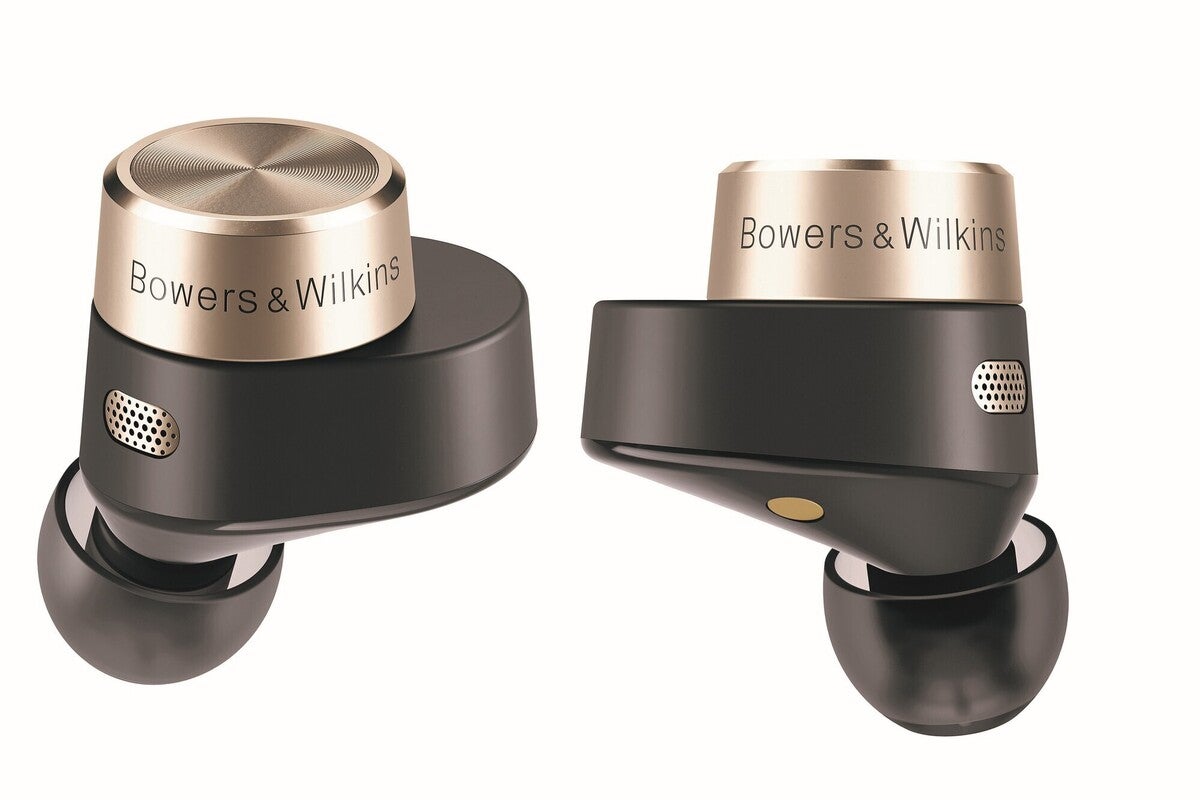 Bowers & Wilkins
Bowers & WilkinsThe B&W PI7 provide a nice, tight fit.
When I plugged the USB-C cable into my 2019 15-inch MacBook Pro, the B&W ProCase appeared as an audio output device in my sound control panel. Selecting “B&W ProCase” as an output, I could then play any music from my Roon media server to the PI7! I cannot tell you how fabulous this feature is. In case you’re wondering, B&W told me that if you are streaming through the ProCase, B&W uses the aptX codec between the case and the PI7.
The ProCase supports both USB-C and wireless charging. Unlike the AirPod Pro’s case that opens around 110-degrees, the B&W PI7’s case opens up only at a 90-degree angle. I found this design made it prone to closing too easily during real-world use—even with the slightest nudge. I’d like to see B&W redesign the cover to open wider in a future revision. Don’t fret about the earbuds falling out, though; the case’s magnets hold the earbuds snugly and you’ll need more force than you might think to pull them out.
The ProCase has a behavior you’ll want aware of: If I was charging the ProCase via USB-C on my MacBook Pro, and an iMessage or any other audio came through, the ProCase would initiate a Bluetooth connection and disconnect the PI7 from other active connection. This isn’t a bug, it’s the expected behavior, however inconvenient it might be at times.
Decent battery life
The PI7 are rated at up to four hours for each earbud with an additional four re-charges from the ProCase (16 hours in total). I found the fast-charge feature to be extremely useful; a 15-minute charge will give you roughly two hours of battery life.
 Theo Nicolakis / IDG
Theo Nicolakis / IDGThe PI7 earbuds drain their batteries unevenly, depending on which one is the primary and which is the secondary.
There’s an asterisk to that battery life: The earbuds don’t drain uniformly. In my testing, I consistently noticed that one earbud’s battery drained far more quickly than the other. If I didn’t recharge the earbuds, the difference reached as much as 37 percent between the two (when one earbud would be totally drained, the other retained 37 percent of its charge).
When I inquired about this discrepancy, a B&W representative said the earbuds operate in a primary (master) and secondary (slave) configuration, with the primary using more battery power. The master/slave assignment changes each time you first use the device, so the faster-draining bud will alternate between the left and right side. B&W says multiple criteria determine which unit is designated as primary and which becomes secondary. My hunch from testing is that whichever one you pull out of the case first tends to become the primary.
Only average active noise cancellation
The PI7 join the increasing lineup of true wireless headphones with a suite of noise cancelling features. The PI7 uses three microphones on each bud in service of both phone calls and for adaptive noise cancellation. The buds monitor, analyze, and adapt their noise cancelling signals in accordance with your surroundings.
To get the most of the B&W’s noise cancelling features, you’ll need the companion mobile app for iOS or Android. The app provides a full range of noise-cancellation features as well as basic battery info, Bluetooth connections, soundscapes, and other settings.
I found the B&W’s noise-cancellation performance to be average. Running through my standard tests of air purifiers, HVAC noise, and blasting airplane cabin noise at 92dB through my in-ceiling speakers, the B&W got the job done, but it didn’t wow me in any particular area. On the other hand, the PI7’s noise cancellation didn’t noticeably impact the music the way it does on many other brands I’ve listened to.
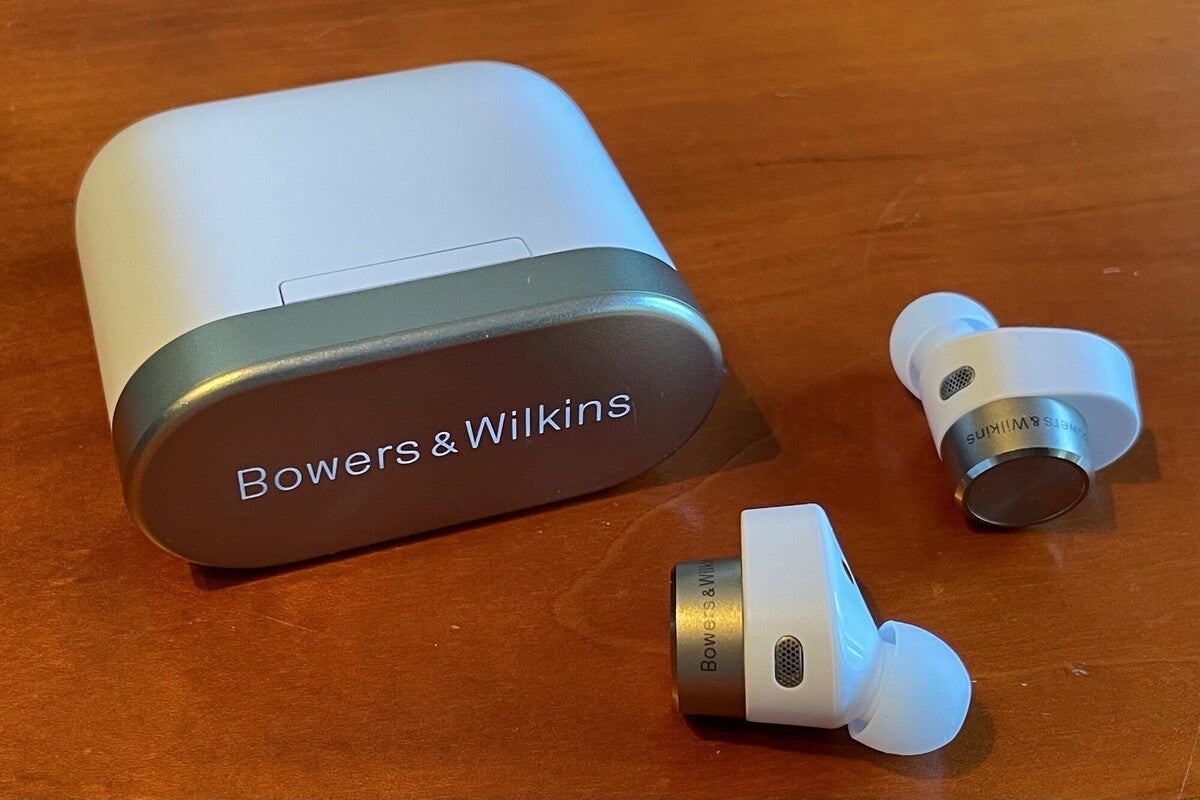 Theo Nicolakis / IDG
Theo Nicolakis / IDGThe B&W PI7 and its smart charging case.
Ambient pass-through (also called transparency mode) lets sound from the outside world in, so you can be aware of your surroundings. You set the level of pass-through via a slider in the app, with “natural” at the middle setting. B&W’s implementation doesn’t achieve the natural feeling of spaciousness and sound that I get from the AirPods Pro. It attenuates the sound of the outside world too much and unevenly until move the slider to between 90 and 100 percent. Increasing ambient pass-through to this level, however, introduced some hiss and occasionally an unnatural sound balance.
Conclusion
Has Bowers & Wilkins achieved its goal of a building a true wireless in-ear headphone that doesn’t compromise sound quality for convenience? In large part, yes. If you’re a serious music lover who can put up with a couple of kinks—especially as related to high-end digital audio player support (or wait for B&W to iron them out)— Bowers & Wilkins’ PI7 true wireless in-ear headphones are a sonic revelation.
Adding to the PI7’s wow factor is the ability to stream music via the ProCase, enabling you to play from a high-end network source like a Roon server—that’s just freaking brilliant. If high-fidelity personal audio is what you seek, you should absolutely take the PI7 for a spin.
For all the latest Technology News Click Here
For the latest news and updates, follow us on Google News.

